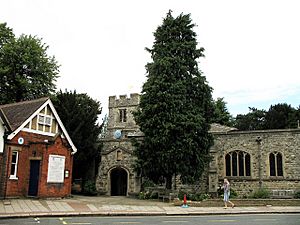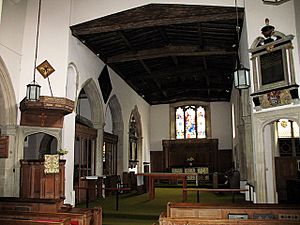St Mary-at-Finchley Church facts for kids
Quick facts for kids St Mary-at-Finchley |
|
|---|---|

St Mary-at-Finchley
|
|
| Country | England |
| Denomination | Church of England |
| Architecture | |
| Heritage designation | Grade II* |
| Style | English Gothic |
| Administration | |
| Parish | Finchley |
| Deanery | Barnet |
| Archdeaconry | Hampstead |
| Episcopal area | Edmonton |
| Diocese | London |
| Province | Canterbury |
St Mary-at-Finchley Church is a special place of worship for the Church of England in Finchley. You can find it in Hendon Lane, right in the middle of town, close to the Finchley Library. It's a historic building that has been part of the community for many centuries.
Contents
A Look Back: The History of St Mary's
St Mary-at-Finchley Church has been around for a very long time, since the 1100s! People first wrote about it in 1274, but there was likely a church building even before that. By 1356, it was officially named after St Mary.
The church building has changed a lot over the years. The oldest parts you can see today, like the north wall and the tower, were built when King Henry VII was in charge (around the late 1400s). During the 1500s and 1600s, the tower even had a tall, pointy steeple!
Inside the church, you can find some very old items. There's an ambry, which is a small cupboard in the wall used to store sacred items. There's also a font bowl, which is a basin used for baptisms. This font was actually buried in the church grounds during the English Civil War to keep it safe and was found again in the 1800s. Both of these items are from the Norman period, meaning they are incredibly old!
In 1872, the church was made bigger to fit more people. A few years later, in 1878, a company called Henry Willis & Sons installed the large organ that the church still uses today.
During World War II, in 1940, London was bombed a lot. This was called the London Blitz. St Mary's Church was badly damaged, especially the east end. The beautiful stained glass windows had to be replaced. After the war, the church was rebuilt in 1953. New parts like the altar (the table where services are held), the reredos (a screen behind the altar), and the pulpit (where the priest gives sermons) were added. The organ was also fixed up and moved to a different part of the church. It had a big restoration in 2011 to make it sound amazing again.
Because of its long history and special architecture, the church has been a Grade II* listed building since 1949. This means it's a very important historical building that needs to be protected.
To celebrate the year 2000, a special wall hanging was created. It shows all the different groups and people who were part of St Mary-at-Finchley at the end of the 1900s. There's a guide next to it that explains what all the symbols mean!
Important People and Memorials
The church has many old monuments and graves. The oldest monument is a brass plate for Richard Prate, who passed away in 1487. There's also a marble statue of Alexander King (who died in 1618) and his wife. Another interesting brass monument belongs to Thomas Sanny from 1509, and it even includes part of his will! You can also find memorials for the Allen family, who used to own the big Manor House in Finchley.
In the churchyard outside, you can find the graves of some famous people. One is Thomas Payne, who was a writer and bookseller known for his radical ideas. Another is Major John Cartwright, who worked hard to make political changes.
Past Leaders of the Church
The church has had many rectors, who are like the main priests in charge, over the centuries. Here are some of the people who have led St Mary-at-Finchley:
- 1527–1533 Walter Preston
- 1535–1554 John Spendlove
- 1558–1581 John Spendlove (he came back!)
- 1581–1599 William Cotton
- 1599–1601 Richard Latewar
- 1601–1608 John Bancroft
- 1608–1615 John Barkham
- 1622–1626 Francis Wright
- 1626–1639 Thomas Worrall
- 1657–1662 Thomas Goldstone
- 1666–1707 John Hall
- 1707–1730 Nathaniel Marshall
- 1731–1743 William Crowe
- 1743–1767 Thomas Archer
- 1767–1770 James Waller
- 1770–1794 Samuel Carr
- 1794–1848 Ralph Worsley
- 1848–1877 Thomas Reader White
- 1900–1924 William St Hill Bourne
- 1924–1941 Stewart Bernays
- 2008– Philip Davison
Want to Learn More?


